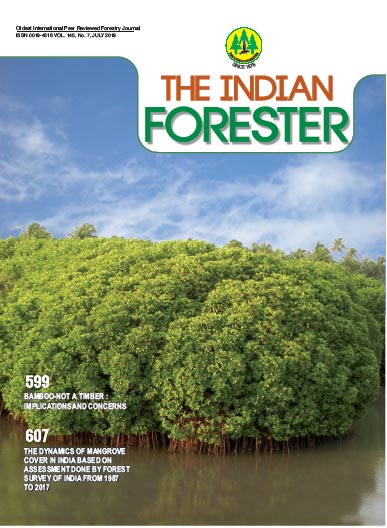Effect of Preinoculation with Indigenous and Introduced Arbuscular Mycorrhizae (AM) on Growth, Biomass and Biochemical Contents of Albizia lebbeck Benth. Seedlings in Acid Lateritic Soil
DOI:
https://doi.org/10.36808/if/2019/v145i7/147021Keywords:
Arbuscular Mycorrhizae (AM), Growth, Biomass, Chlorophyll, Mycorrhizal Dependenc.Abstract
Afforestation in most tropical soils is a real problem as those are not only P-deficient but also P-fixing. Acid lateritic soil is dry and deficient in essential nutrients and rich in Al and iron. Application of chemical fertilizer is of little use and expensive for plantation in this soil type. Nursery inoculation with selected arbuscular mycorrhizal (AM) fungi, as phosphate biofertilizer may be a better option. Albizia lebbeck Benth is widely used as avenue tree roadsides and in tea and coffee plantations; and a good quality fodder. Inoculation of the tree seedlings in nursery with three indigenous AM-fungal isolates: Glomus aggregatum, Acaulospora delicata, Paraglomus occultum and one introduced Glomus mosseae enhanced growth within 60 days. At 240th day, maximum total biomass was enormously high (P<0.001); in treatments of G. aggregatum (140%), followed by A. delicata (135%), G. mosseae (134%) and Paraglomus occultum (121%). Shoot P content was also increased significantly (P<0.01) in all AMF treatments except in Paraglomus occultum (P<0.05) than control. Mycorrhizal dependency on G. aggregatum is maximum (58.3%), on A. delicata and G. mosseae was almost same (57.1-57.5 %), least dependency on Paraglomus occultum (54.7%).References
Arnon D.I. (1949) Copper enzyme in isolated chloroplasts, polyphenoloxidase in Beta vulgaris. Plant Physiology, 24: 1-5.
Aúge R.M. (2001). Water relations, drought and vesicular – arbuscular mycorrhizal symbiosis. Mycorrhiza, 11: 3-42.
Bagyaraj D.J. (1984). Biological interactions with VAM fungi. In: Mycorrhiza, (Powell CL and Bagyaraj DJ, Eds.). Boca Raton: CRC Press. ISBN: 0-8493-5694-6: 131-153pp.
Bagyaraj D.J. and Reddy B.J.D. (2000). Arbuscular mycorrhizas in sustainable development and productivity. In: Microbial biotechnology for sustainable development and productivity (R.C. Rajak, Eds), Jodhpur, India. Scientific, 43-53 pp.
Bolan N.S. (1991). A critical review on the role of mycorrhizal fungi in the uptake of phosphorous by plants. Plant soil, 134: 189-207.
Champion H.G. and Seth S.K. (1968). A revised survey of the forest types of India. Manager of publications. Delhi, India.
Cruz R.E., de la., Zarade J.F., Agganzae N.S. and Lorilla E.B. (1999). Differential mycorrhizal development of some agricultural, horticultural and forestry crops to inoculation of mycorrhizal fungi. In: Proceedings of the International Symposium on management of Mycorrhizas in Agriculture, Horticulture and Forestry, Jasper, D. (Australian Institute of Agricultural Sciences, Australia. 54 p.
Davies E.A., Young J.L. and Linderman G. (1983). Soil lime level (pH) and VA-mycorrhizal effects on growth response of Sweetgum seedlings. Soil Sci. Soc. Amer. J., 47: 251-256.
Dickson A., Leaf A. and Hosner J.F. (1960). Quality appraisal of white spruce and white pine seedling stock in nurseries. Forestry Chronicle, 36: 10-13.
Gerdemann J.W. and Nicolson T.H. (1963). Spores of mycorrhizal Endogone species extracted from soil by wet sieving and decanting. Trans. Br. Mycol. Soc., 46: 235-244.
Haselwandter K. (1997). Soil micro-organisms, mycorrhiza and restoration ecology. In: Restoration Ecology and sustainable development. (Urbanska K, Webb, N., Edwards P.J, Eds) pp 65-80. Cambridge. Cambridge University Press.
Jackson M.L. (1973). Soil chemical analyses. New Delhi, India Prentice – Hall. 239-241pp.
Koley A.K. (2000). Basic concepts of soil science. 2nd Ed. New age international publishers, India.
Mamatha G., Bagyaraj D.J. and Jaganath S. (2002). Inoculation of field established mulberry and papaya with arbuscular mycorrhizal fungi and a helper bacterium. Mycorrhiza, 12:313-316.
Menge J.A., Johnson E.L.V. and Platt R.G. (1978). Mycorrhizal dependency of several citrus cultivars under three nutrient regimes. New Phytologist, 81: 553–559.
Pavan Kumar P., Reddy S.R. and Reddy S.M. (2000). Mycorrhizal dependency of some agro forestry tree species. Indian Forester, 126(4): 397-401.
Pearcy P.W. (1987). Carbon gain by plants in natural environments. Biosciences. 37 (1): 21-29.
Phillips J.M and Hayman D.S. (1970). Improved procedure for clearing roots and staining parasitic vesicular-arbuscular mycorrhizal fungi for rapid assessment of infection. Trans. Br. Mycol. Soc., 55: 158-161.
Plenchette C., Fortin J.A. and Furlan Z. (1983). Growth response of several plant species to mycorrhiza in soil of moderate P fertility. I. mycorrhizal development under field conditions. Plant and Soil, 70(2): 199-209.
Robson A.D. and Abbott L.K. (1989). The effect of soil acidity on microbial activity in soils. In:. Soil acidity and plant growth. (Robson A.D., Ed) San Diego. Academic Press 139-165pp.
Schenck N.C. and Perez V. (1987) Mannual for identification of VA-Mycorrhizal fungi. Gainsville, USA. Synergistic publication.
Tinker P.B. (1984) The role of microorganisms in mediating and facilitating the uptake of plant nutrient from soil. Plant Soil, 76: 77-91.
van der Heijden, Boller G.A.T., Wiemken A. and Sanders I.R (1998). Different arbuscular mycorrhizal fungal species are potential determinants of plant community structure. Ecology, 79: 2082-2091.
Verma N.K. (1988). Effect of VA mycorrhizae on growth and P uptake in grown soil:amended with soluble phosphate. J. Nat. Bot. Soc., 52: 41-45.
Wilson D.O. (1988). Differential plant response to inoculation with two VA mycorrhizal fungi. Plant soil, 110: 69.
Gazey C., Abbott L.K. and Robson AD. (2004). Indigenous and introduced Arbuscular mycorrhizal fungicontribute to plantgrowth in two agricultural soils from south western Australia. Mycorrhiza 16(6): 355-362.
Downloads
Downloads
Published
How to Cite
Issue
Section
License
Unless otherwise stated, copyright or similar rights in all materials presented on the site, including graphical images, are owned by Indian Forester.





